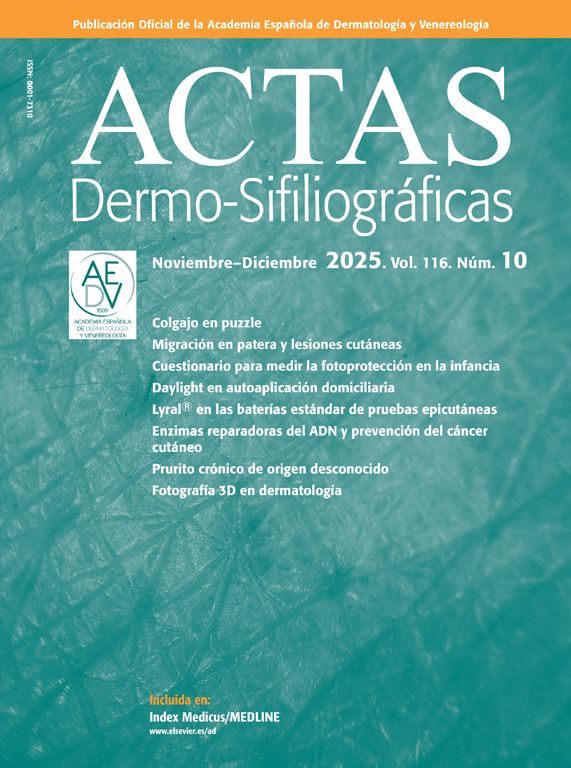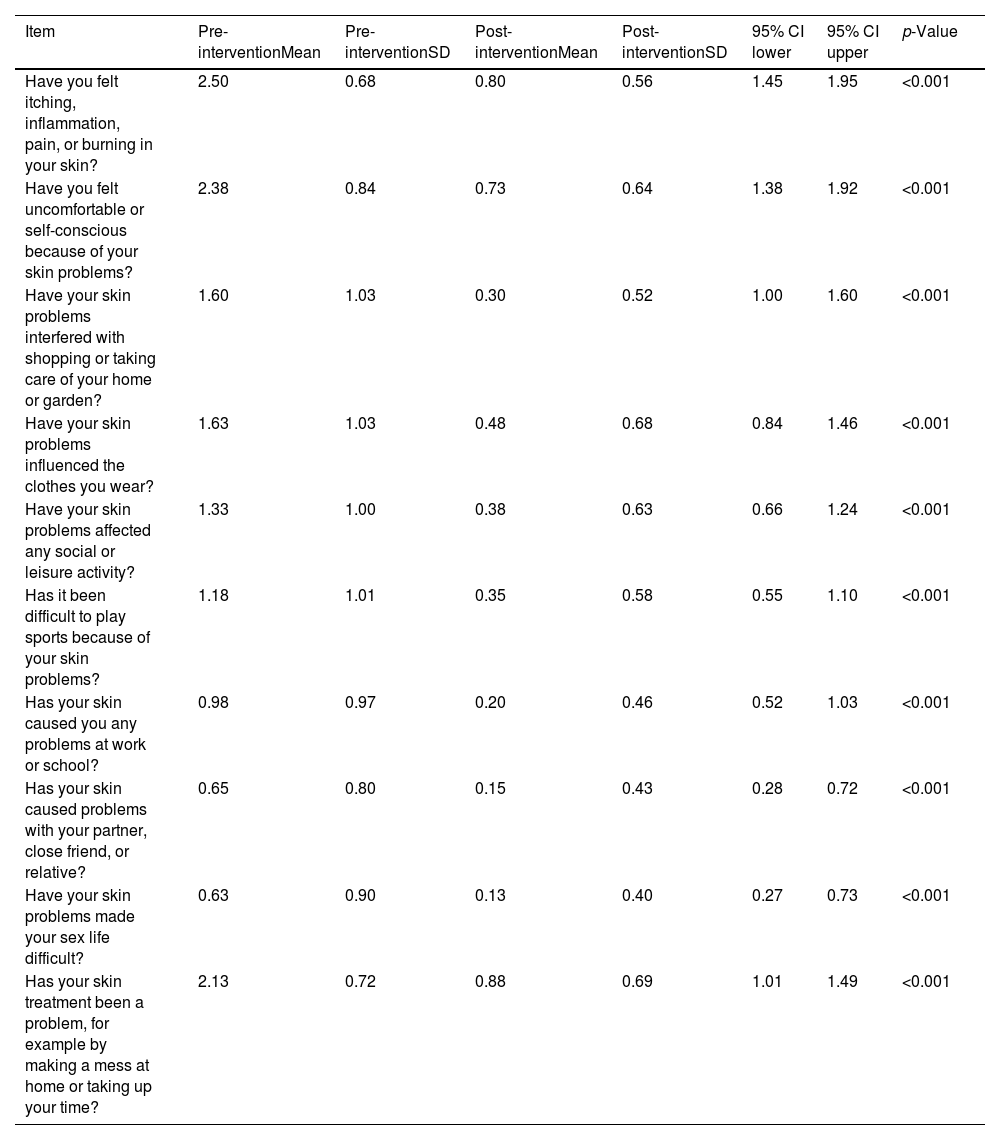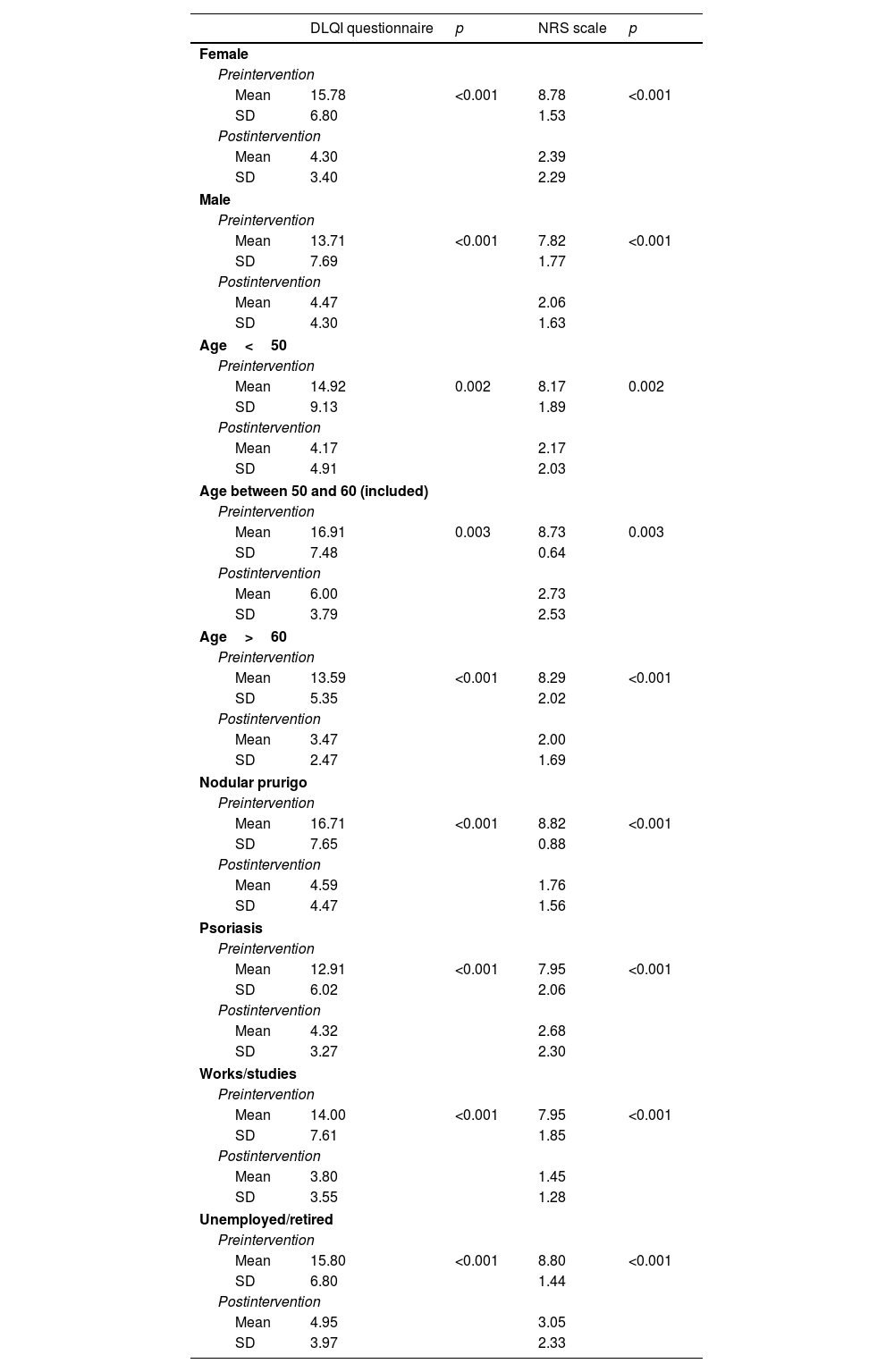The quality of life of patients with chronic dermatological disease is compromised by symptoms that affect their emotional and social well-being.1 Identifying the most affected aspects of quality of life will allow the design of strategies to reduce stigma and symptoms associated with the disease.2 Therefore, this study was designed with the aim of identifying what changes in quality of life and in the intensity of pruritus occurred in patients with a chronic dermatological disease after treatment with phototherapy, during dermatology nursing consultations.
This quasi-experimental, pre-post intervention study included patients older than 18 years, selected through non-probabilistic sampling, who attended the dermatology service from May to October 2023, with a diagnosis of psoriasis or nodular prurigo, and were eligible for narrowband UVB (NB-UVB) phototherapy. Treatment was administered at a protocolized dose based on the patient's characteristics and disease progression, with a 3-month regimen in 2–3 weekly sessions, in the nurse-led dermatology consultation at a tertiary public referral center in the Castile and León public health system (Castile and León, Spain).
Sociodemographic, clinical, and outcome variables were included. Quality of life was measured using the Dermatology Life Quality Index (DLQI),3 and itching was assessed 24h prior to session #1 using the Numerical Rating Scale for Maximum Pruritus (NRS).4
A total of 39 patients were included (22 (56.4%) women and 17 (43.6%) men) with a mean age of 53.2 years (SD: 16.3). Twenty-two of these (56.4%) had psoriasis and 17 (43.6%), nodular prurigo; 19 (48.7%) were employed, and 20 (51.3%) were not.
Significant changes were observed in the mean values of quality of life, pruritus, and the severity of prurigo and psoriasis, pre- and post-intervention (Table 1).
Mean pre- and post-intervention scores for DLQI questionnaire, NRS scale, PASI, and PAS.
| Pre-interventionMean | Pre-interventionSD | Post-interventionMean | Post-interventionSD | p-Value | |
|---|---|---|---|---|---|
| Dermatology Life Quality Index (DLQI) | 14.88 | 7.18 | 4.41 | 3.84 | <0.001 |
| Numerical Rating Scale (NRS) for Maximum Pruritus | 8.40 | 1.72 | 2.28 | 1.96 | <0.001 |
| Prurigo Activity Score (PAS) | 14.80 | 4.83 | 3.63 | 3.25 | <0.001 |
| Psoriasis Area and Severity Index (PASI) | 13.52 | 7.27 | 4.81 | 2.68 | <0.001 |
A detailed analysis of each DLQI item is shown in Table 2; the items where the worst quality of life was reported were: “feeling itchy, sore, painful, or stinging in the skin,” followed by “feeling uncomfortable due to skin problems” and “the burden of skin treatment.”
Comparison of mean scores for the 10 items of the DLQI questionnaire, pre- and post-intervention.
| Item | Pre-interventionMean | Pre-interventionSD | Post-interventionMean | Post-interventionSD | 95% CI lower | 95% CI upper | p-Value |
|---|---|---|---|---|---|---|---|
| Have you felt itching, inflammation, pain, or burning in your skin? | 2.50 | 0.68 | 0.80 | 0.56 | 1.45 | 1.95 | <0.001 |
| Have you felt uncomfortable or self-conscious because of your skin problems? | 2.38 | 0.84 | 0.73 | 0.64 | 1.38 | 1.92 | <0.001 |
| Have your skin problems interfered with shopping or taking care of your home or garden? | 1.60 | 1.03 | 0.30 | 0.52 | 1.00 | 1.60 | <0.001 |
| Have your skin problems influenced the clothes you wear? | 1.63 | 1.03 | 0.48 | 0.68 | 0.84 | 1.46 | <0.001 |
| Have your skin problems affected any social or leisure activity? | 1.33 | 1.00 | 0.38 | 0.63 | 0.66 | 1.24 | <0.001 |
| Has it been difficult to play sports because of your skin problems? | 1.18 | 1.01 | 0.35 | 0.58 | 0.55 | 1.10 | <0.001 |
| Has your skin caused you any problems at work or school? | 0.98 | 0.97 | 0.20 | 0.46 | 0.52 | 1.03 | <0.001 |
| Has your skin caused problems with your partner, close friend, or relative? | 0.65 | 0.80 | 0.15 | 0.43 | 0.28 | 0.72 | <0.001 |
| Have your skin problems made your sex life difficult? | 0.63 | 0.90 | 0.13 | 0.40 | 0.27 | 0.73 | <0.001 |
| Has your skin treatment been a problem, for example by making a mess at home or taking up your time? | 2.13 | 0.72 | 0.88 | 0.69 | 1.01 | 1.49 | <0.001 |
Table 3 illustrates the results compared by gender, age group, dermatological diagnosis, and employment status.
Comparison of mean (SD) DLQI and NRS scores, pre- and post-intervention, by gender, age group, diagnosis (excluding atopic dermatitis due to only one case), and employment status.
| DLQI questionnaire | p | NRS scale | p | |
|---|---|---|---|---|
| Female | ||||
| Preintervention | ||||
| Mean | 15.78 | <0.001 | 8.78 | <0.001 |
| SD | 6.80 | 1.53 | ||
| Postintervention | ||||
| Mean | 4.30 | 2.39 | ||
| SD | 3.40 | 2.29 | ||
| Male | ||||
| Preintervention | ||||
| Mean | 13.71 | <0.001 | 7.82 | <0.001 |
| SD | 7.69 | 1.77 | ||
| Postintervention | ||||
| Mean | 4.47 | 2.06 | ||
| SD | 4.30 | 1.63 | ||
| Age<50 | ||||
| Preintervention | ||||
| Mean | 14.92 | 0.002 | 8.17 | 0.002 |
| SD | 9.13 | 1.89 | ||
| Postintervention | ||||
| Mean | 4.17 | 2.17 | ||
| SD | 4.91 | 2.03 | ||
| Age between 50 and 60 (included) | ||||
| Preintervention | ||||
| Mean | 16.91 | 0.003 | 8.73 | 0.003 |
| SD | 7.48 | 0.64 | ||
| Postintervention | ||||
| Mean | 6.00 | 2.73 | ||
| SD | 3.79 | 2.53 | ||
| Age>60 | ||||
| Preintervention | ||||
| Mean | 13.59 | <0.001 | 8.29 | <0.001 |
| SD | 5.35 | 2.02 | ||
| Postintervention | ||||
| Mean | 3.47 | 2.00 | ||
| SD | 2.47 | 1.69 | ||
| Nodular prurigo | ||||
| Preintervention | ||||
| Mean | 16.71 | <0.001 | 8.82 | <0.001 |
| SD | 7.65 | 0.88 | ||
| Postintervention | ||||
| Mean | 4.59 | 1.76 | ||
| SD | 4.47 | 1.56 | ||
| Psoriasis | ||||
| Preintervention | ||||
| Mean | 12.91 | <0.001 | 7.95 | <0.001 |
| SD | 6.02 | 2.06 | ||
| Postintervention | ||||
| Mean | 4.32 | 2.68 | ||
| SD | 3.27 | 2.30 | ||
| Works/studies | ||||
| Preintervention | ||||
| Mean | 14.00 | <0.001 | 7.95 | <0.001 |
| SD | 7.61 | 1.85 | ||
| Postintervention | ||||
| Mean | 3.80 | 1.45 | ||
| SD | 3.55 | 1.28 | ||
| Unemployed/retired | ||||
| Preintervention | ||||
| Mean | 15.80 | <0.001 | 8.80 | <0.001 |
| SD | 6.80 | 1.44 | ||
| Postintervention | ||||
| Mean | 4.95 | 3.05 | ||
| SD | 3.97 | 2.33 | ||
Literature agrees that phototherapy is an appropriate therapeutic option for patients with pruritus and that the impact of symptoms must be addressed individually.4,5
These results are similar to those from studies conducted with systemic treatments, suggesting that it may be beneficial to consider the use of combined therapies in patients with room for improvement.6
The most affected aspects after treatment were the difficult-to-treat symptoms typical of chronicity, which may improve with additional treatments or interventions.5 The discomfort caused by the disease may stem from its visual impact, both personally and socially. The relevance of how skin disease affects overall appearance has been highlighted, as it may trigger psychiatric comorbidities.4 The lowest-rated item was “the burden of skin treatment.” These chronic conditions require continuous self-care to avoid worsening, which involves time and dedication.7
Female patients reported greater impairment in quality of life and pruritus prior to treatment. This may be due to women experiencing a greater emotional impact because of social expectations, which worsens their overall distress before receiving appropriate treatment. These differences in perceived disease burden suggest that therapy optimization may require gender-specific considerations and confirm the need to increase the number of studies assessing the impact of disease and treatment by gender.8
Work performance is also affected. Job choice, absenteeism, and clothing selection, among others, are factors identified in studies as having a significant impact on work life or its absence.9
Some studies conclude that younger patients experience a greater decline in quality of life due to social stigma and social relationships; whereas in patients aged 30–50 years, this is linked to greater knowledge of the disease and stronger social relationships, which positively influence quality of life. Therefore, age range should be taken into consideration when planning treatment.10
The study limitations are inherent to its design. As a self-administered questionnaire was used, desirability bias may exist. The study setting is specific, which limits the generalizability of the results.
In conclusion, the influence of chronic dermatological conditions on quality of life was evident. Phototherapy treatment improved patients’ perception of their quality of life and reduced pruritus. However, we saw that some patients still had suboptimal quality of life scores after the intervention. Being a woman, aged 50–60 years, with nodular prurigo and not currently employed was associated with a greater impact on quality of life and pruritus intensity.
Conflicts of interestNone declared.






